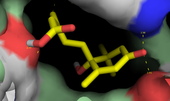Highlight
Chemicals that Control Plant Stress Pathways: New Soilidiers for the Blue Revolution
Achievement/Results
Crops and other plants are constantly confronted with adverse environmental conditions, lowering yield and costing farmers billions of dollars annually. Plants use specialized signals, called stress hormones, to sense difficult times and adapt to stressful conditions to enhance survival. Of the various stress hormones, abscisic acid (ABA), produced naturally by plants, has emerged over the last 30 years as the key hormone that helps plants cope with drought conditions. Under such stress, plants increase their ABA level, which helps them survive the drought through a process not fully understood. So critical is this endogenous chemical to plant survival that researchers have engineered new drought-resistant crops by tinkering with the ABA pathway.
For years, scientists have contemplated spraying ABA directly onto crops to enhance their protection in times of stress. But ABA is a costly, complicated and light-sensitive molecule that has not found use in agriculture. Now new research from the laboratory of Sean Cutler, an assistant professor of plant cell biology in the Department of Botany and Plant Sciences at the University of California, Riverside, suggests the possibility of spraying stable synthetic chemicals on plants to enhance stress tolerance during times of drought and improve yield.
This breakthrough rests on the use of a new method called chemical genomics, pioneered by UC Riverside researchers with funding from an NSF IGERT award. Using this approach, Cutler identified pyrabactin, a new synthetic chemical that turns on the ABA signaling pathway in Arabidopsis, a small flowering plant used widely in plant biology laboratories as a model organism. His lab then used pyrabactin to fish out a receptor for ABA, a highly controversial topic involving retractions of scientific papers as well as the publication of papers of questionable significance. A receptor is a protein molecule in a cell to which mobile signaling molecules may attach. Usually at the top of a signaling pathway, it functions like a boss relaying orders to the team below that then executes particular decisions in the cell. ‘Scientists have been trying to solve the ABA receptor problem for more than 20 years, and claims for ABA receptors are not easily received by the scientific community,’ said Cutler, who came to UCR in 2007 from the University of Toronto. ‘We screened thousands of chemicals for one that mimics ABA. We found pyrabactin activates some of the ABA receptors in plants and is an excellent mimic of ABA. Moreover, unlike ABA, it is stable and easy to make. It therefore suggests a highly effective chemical strategy for improving plants’ ability to survive under low-water conditions, potentially benefiting farmers in drought-prone areas worldwide.’
Cutler’s approach highlights the power of the chemical genetic approach for uncovering new leads for agrichemistry and, in turn, using those leads to understand a biological process. ‘This is a striking example of how a chemical allowed us to solve a problem that genetics has been struggling with,’ he said. ‘Clearly, chemical genetics can be used to bypass some of the limitations that slow down classical genetic analysis. Not too long ago, the United Nations called for a “blue revolution”, the water equivalent of the green revolution, of improved water management and sharing. We have proven that we can enlist chemicals that modulate stress responses in crops as soldiers in the blue revolution. Now our goal is to design the best chemical soldiers possible.’
Study results appear April 30 in Science Express and in the May 22 issue of Science magazine. The Science paper is accompanied by a patent application with IGERT trainee Andrew Defries as a co-inventor. Defries, an expert in the automation of screening methods, developed methods for rapidly identifying new synthetic chemicals that activate the ABA receptors described in the Science manuscript. Defries’ ground breaking work, which involved hundreds of thousands of chemical assays that he conducted in a period of weeks, sets the stage for industrial scale chemical screens for new modulators of plant stress physiology and water use.
Address Goals
This work is proof that the chemical genomic approach to dissecting plant biological problems, pioneered at UCR and supported by the NSF, leads to important discoveries. It also creates unprecedented training opportunities. Andrew Defries is a biologist by training, but is now involved in synthesizing new bioactive molecules and collaborating with chemists on the design and synthesis of new chemical agents that modulate plant physiology. The IGERT grant has enabled a new generation of chemistry savvy biologists to be trained (and vice versa). This approach is having an impact locally, nationally and internationally.








